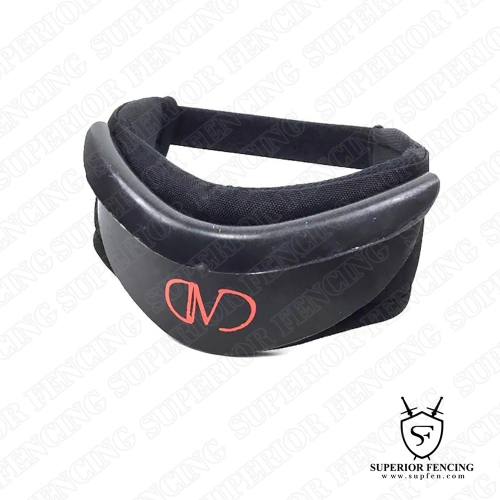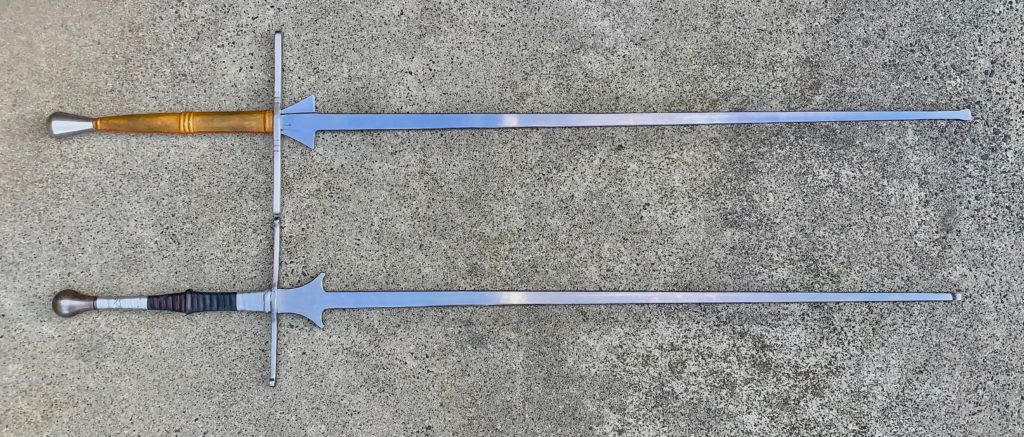When you start historical fencing it’s hard to resist the urge to run out and buy the first sword you see.
Hopefully this guide will be helpful in considering your purchase options.
What to Get and When?
There are lots of options regarding equipment, so don’t rush into it. When purchasing gear the typical order of priority is:
- Mask, Overlay (get this as soon as possible)
- Throat protector & Gloves…oh and Groin protector too!
- Sword (3-6 months) – please read about the requirements for sword ownership in Victoria.
- Everything else (later)
Of course realistically people just want to rush out and order a sword, which is fine, just remember that you REALLY should invest in a mask – your eyes are quite important… and your teeth… and probably your good looks too 😉
There are options in each category depending only your budget. Typically the best way to decide what is best for you is to speak to other students in the class about their experiences. This guide will give our own experience, but opinions may vary. If you want to explore a bunch of manufacturers then go to the WMA equipment Wiki on reddit.
How to Buy
Most of the equipment for HEMA comes from Europe and there can be significant postage costs and wait times.
The best thing to do is talk to your school about creating a group order for gear then splitting postage costs – you will save a lot of money this way.
Many products take a long time to be delivered as they are made to order. Swords typically take the longest and can take up to a year to arrive from some manufacturers.
Other equipment – masks, knee and shin guards etc. are much quicker and are usually in stock – always ask your fellow students about their experiences – a beautiful sword is no good if it takes 18 months to arrive.
For some elements of basic gear there are a few local resellers such as The Historical Fencing Shop.
Masks
Masks are usually in stock and will usually arrive from most manufacturers within 4 – 6 weeks.
350N Masks vs 1600N Masks
The rating refers to puncture resistance of the fabric (bib) as well as the quality of the mesh (you’ll also see CEN rating 1 and 2 used – 1 being the weaker and 2 the higher strength construction). 350N masks are generally less expensive and are adequate for basic training, though we highly recommend 1600N when buying your own mask.
If suspect that you may want to participate in competitions one day, then we consider a 1600N mask the appropriate choice.
Options
If you’re opting for a 350N mask the AF basic HEMA mask is the one we usually use in class. It is fairly low cost, and we can get the mask for around $100 Australian.
A popular 1600N masks at the moment is the Uhlmann 1600N Coaches’ Mask. This mask is durable and well padded, and comes in the standard mask sizes.
Leon Paul masks are also excellent and can be ordered online through Leon Paul Australia. They offer HEMA specific masks, as well as overlays.
Some people favour the Gajardoni masks, and Negrini also offers a suitable mask.
PBT Historical Fencing are another manufacturer who provide masks and overlays (as well as other gear). Their equipment is generally reasonably good quality though we don’t recommend their 350N masks as we have seen these bend under fairly light blows.
In addition to a mask you’ll need an overlay – this is the padded outer covering which acts as a shock absorber and protects from over-excited opponents. PBT, SPES, or Leon Paul all have overlays with rigid sections in the rear which provide good protection.
A new entry to the market is the Wukusi mask, which combines rigid coverage all around and provides excellent protection for HEMA.
Throat Protection
An often overlooked piece of kit, this is the thing that stops you getting stabbed in the throat if a sword sneaks under the bib of your mask. Opinions on throat protectors are divided.
The “default” option you’ll see people wearing is the PBT protector. It’s a decent option, does its job well, and can be modified when you get it to meet your particular preferences.

Superior fencing offer a virtually identical protector, which they seem to have copied directly from the PBT model. The only downside to both is that the throat insert is only semi-rigid, and some (only one really) tournaments require rigid throat protection.
A minimalist option is the “Roughneck” Gorget; this is a low profile design however unlike the PBT it has a rigid front plate with blade catching lip. The Roughneck is available from Superior Fencing, Black Armoury, and other retailers.

Gloves
Hands get hit quite a lot in HEMA, generally during sparring. The choice of glove is entirely up to the student, and depends on your needs.
For longsword drills, as well as for sidesword and sabre the Red Dragon glove is a good option at a reasonable price. Delivery time for these is quite short.
There are lighter drilling gloves available as well, such as those supplied by Superior Fencing (SupFen), who also supply heavier glove variants.
For full speed sparring with longswords we recommend the Fechtschule Gdansk Sparring Glove. This glove offers the best protection of any we’ve seen, and is definitely the lightest option. It does use the ‘clamshell’ design which takes a little getting used to, but the additional protection is worth it (ask any of us who have had a finger broken after using different gloves to these). These gloves can be made in custom sizes, including with an extended cuff for arm protection
The customer service for sparring gloves is impressive, and their sales-rep Barbara is extremely helpful – as a plus they will happily replace gloves which fail due to defect. Allow 2 – 3 months at least for these gloves to arrive.
Finally SPES Heavy Gloves have been popular for many years. While bulky they offer great protection – we do advise that you purchase the upgraded thumb protector.
Red dragon gloves and Sparring Gloves
Groin Protection (ouch)
Ensure you wear a groin protector too if you’re male.
This is an easy low cost item and is easy to pick up early in your fencing career. There are many options, though we prefer the Shock-Doctor range of products which come in different styles and materials.
SWORDS!!!
This is what everyone is excited to get hold of. We’re fortunate now that there are many manufacturers. We recommend swords with a relatively flexible blade (10-15kg flex weight), and if you’re intending to compete then most events don’t allow anything over 1.6kg, and 100cm in blade length.
Here are a few options, though you should talk to your instructor and other students before buying.
Regenyei Armoury is an old favourite for basic training gear. They’re quite consistent and reasonable quality at a decent price point. If you’re looking for a basic weapon for longsword training then their standard feders (feder is the modern term most often used for blunt training weapons like those shown in the images below) are a good choice, though they manufacture side-swords, sharp longswords, and most other swords you might want.
They offer all types of customisation including lighter or heavier blades, and different lengths. We prefer the “medium” blade for their feders – if you’re intending to buy and train at Scholar Victoria, please choose the medium flex blade. Delivery times are up to 6 months, though usually more like 3 months for most clubs.
SIGI Forge are relative newcomers and now offer a variety of longsword training swords. They are excellent quality and have great handling characteristics, and are the sword of choice for many competitive fencers. For a review of the SIGI swords check out the Review on Our Blog.
Kvetun Armoury make very nice sideswords and sabres, and they offer a range of feders too. They also have excellent customer service and can work with you to create the sword you’re looking for.

There are many other manufacturers such as Ensifer, Aureus Swords, Malleus Martialis, Bloss, Pavel Moc and more – ask your fellow students about their experiences.
Delivery times for some makers are up to a year!! (usually it’s 3 months or so for most decent fabricators).
NOTE: On the up-side many manufacturers don’t ask for money until your sword is ready so if you order you won’t have to pay until they ship it.
Jackets & Trousers & other Protectors
Get the jacket first – trousers can be acquired later. When buying, ensure that the equipment is at least 350N rated. Many competitions and events require at least 350N for jackets.
Our preferred jackets and trousers are from SPES, specifically their AP Range of Jackets. These come in different thicknesses/weights as well as sizes and colours, and are durable and popular in the community. The Standard AP is suitable for all intensities of longsword fencing.
SPES also have elbow and knee protectors which are integrated into their range – these are essential equipment whether you get the SPES version or not.
Another jacket gaining popularity for longsword fencing is the Black Armoury jacket. The throat protector on this is unique in that it goes over the mask bib, making it mobile and protective. Our experience with these is that they’re a very light comfortable jacket of good quality.
Superior Fencing offer a series of low-cost options for fencing gear. These products are pretty good in terms of quality, though fit and finish isn’t quite as good as the more expensive brands. They are fine if you’re starting out and don’t want to commit too much money to the sport.
SPES, Neyman, and Black Armoury jackets
Forearms and Shins & More
These are necessary for longsword sparring at full speed.
If you have Fechtschule Gdansk Sparring Gloves with extended cuffs then your forearms are covered and well protected – just wear elbow protectors.
If not then Superior Fencing, SPES, Neyman, and other manufacturers all make forearm protection. Be aware that the cuff on your gloves may interfere with forearm protection, so ask to try out your fellow students’ gear before you buy.
Shins are easier – while manufacturers such as SPES and Neyman do make specific protectors a pair of hockey shin guards from Rebel Sport are a good choice – they cover the sides as well as the front of the shin all the way down to the ankle, and our experiences with them have been good. Of course ensure you have knee protectors too – SPES trousers have specific knee protectors for their trousers, but there are many other options.
